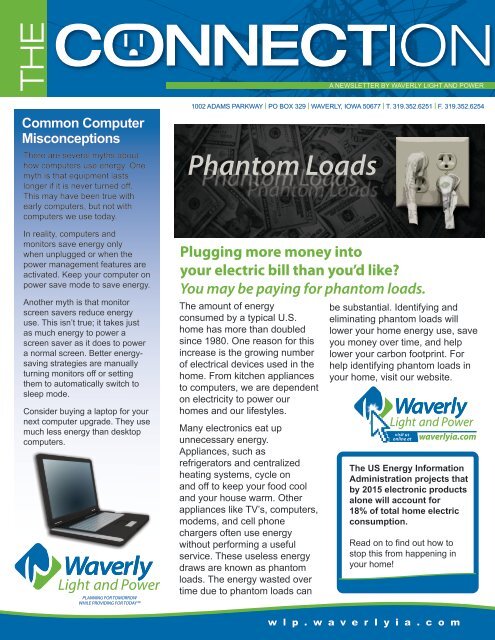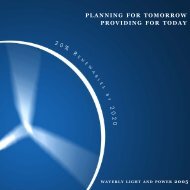Phantom Loads - Waverly Light and Power
Phantom Loads - Waverly Light and Power
Phantom Loads - Waverly Light and Power
You also want an ePaper? Increase the reach of your titles
YUMPU automatically turns print PDFs into web optimized ePapers that Google loves.
Common Computer<br />
Misconceptions<br />
There are several myths about<br />
how computers use energy. One<br />
myth is that equipment lasts<br />
longer if it is never turned off.<br />
This may have been true with<br />
early computers, but not with<br />
computers we use today.<br />
In reality, computers <strong>and</strong><br />
monitors save energy only<br />
when unplugged or when the<br />
power management features are<br />
activated. Keep your computer on<br />
power save mode to save energy.<br />
Another myth is that monitor<br />
screen savers reduce energy<br />
use. This isn’t true; it takes just<br />
as much energy to power a<br />
screen saver as it does to power<br />
a normal screen. Better energysaving<br />
strategies are manually<br />
turning monitors off or setting<br />
them to automatically switch to<br />
sleep mode.<br />
Consider buying a laptop for your<br />
next computer upgrade. They use<br />
much less energy than desktop<br />
computers.<br />
PLANNING FOR TOMORROW<br />
WHILE PROVIDING FOR TODAY<br />
<strong>Phantom</strong> <strong>Loads</strong><br />
Plugging more money into<br />
your electric bill than you’d like?<br />
You may be paying for phantom loads.<br />
The amount of energy<br />
consumed by a typical U.S.<br />
home has more than doubled<br />
since 1980. One reason for this<br />
increase is the growing number<br />
of electrical devices used in the<br />
home. From kitchen appliances<br />
to computers, we are dependent<br />
on electricity to power our<br />
homes <strong>and</strong> our lifestyles.<br />
Many electronics eat up<br />
unnecessary energy.<br />
Appliances, such as<br />
refrigerators <strong>and</strong> centralized<br />
heating systems, cycle on<br />
<strong>and</strong> off to keep your food cool<br />
<strong>and</strong> your house warm. Other<br />
appliances like TV’s, computers,<br />
modems, <strong>and</strong> cell phone<br />
chargers often use energy<br />
without performing a useful<br />
service. These useless energy<br />
draws are known as phantom<br />
loads. The energy wasted over<br />
time due to phantom loads can<br />
be substantial. Identifying <strong>and</strong><br />
eliminating phantom loads will<br />
lower your home energy use, save<br />
you money over time, <strong>and</strong> help<br />
lower your carbon footprint. For<br />
help identifying phantom loads in<br />
your home, visit our website.<br />
The US Energy Information<br />
Administration projects that<br />
by 2015 electronic products<br />
alone will account for<br />
18% of total home electric<br />
consumption.<br />
Read on to find out how to<br />
stop this from happening in<br />
your home!<br />
w l p . w a v e r l y i a . c o m
Reduce your energy consumption<br />
Simple ways to reduce phantom loads in your home<br />
The easiest way to stop phantom loads is to unplug all<br />
electrical devices when not in use. However, we all know it<br />
can be difficult to get to the plugs behind furniture. Consider<br />
buying power strips with a real off switch (called a smart<br />
strip) <strong>and</strong> plugging multiple devides into it. <strong>Power</strong> strips<br />
make it easy to turn off many devices at once when they<br />
are not needed. Some strips, such as the one pictured, will<br />
automatically shut off the power to some devices when they<br />
are turned off.<br />
WHERE’S THE PHANTOM LOAD?<br />
See if you can spot the energy users in your home.<br />
Many appliances cause phantom<br />
loads. An easy way to spot an energy<br />
user is to look for anything with instant<br />
on features, which can be identified<br />
as a light or clock. Appliances with<br />
remote controls also use energy all<br />
of the time. Chargers left plugged in<br />
use electriciy even when they are not<br />
charging anything.<br />
Most homes have many devices using<br />
unnecessary electricity, <strong>and</strong> the trend<br />
is growing. Count how many of these<br />
devices are in your home <strong>and</strong> then<br />
take steps to reduce your phantom<br />
loads <strong>and</strong> save money.<br />
<strong>Phantom</strong> Load Examples<br />
• VCRs\DVRs<br />
• DVD players<br />
• Audio systems<br />
• Computers <strong>and</strong> printers<br />
• TVs<br />
• Set-top (cable) boxes<br />
• Microwave ovens<br />
• Coffee makers<br />
• Air conditioning systems with remote<br />
control<br />
• Devices with a st<strong>and</strong>by light or clock<br />
• Video game consoles (e.g., Nintendo,<br />
Wii, Microsoft Xbox 360, Sony<br />
PLAYSTATION® 3)<br />
• Fans with remote controls<br />
R<br />
iCC<br />
PLANNING FOR TOMORROW<br />
WHILE PROVIDING FOR TODAY<br />
1002 ADAMS PARKWAY<br />
PO BOX 329<br />
WAVERLY, IOWA 50677<br />
PHONE 319.352.6251<br />
FAX 319.352.6254<br />
w l p . w a v e r l y i a . c o m





